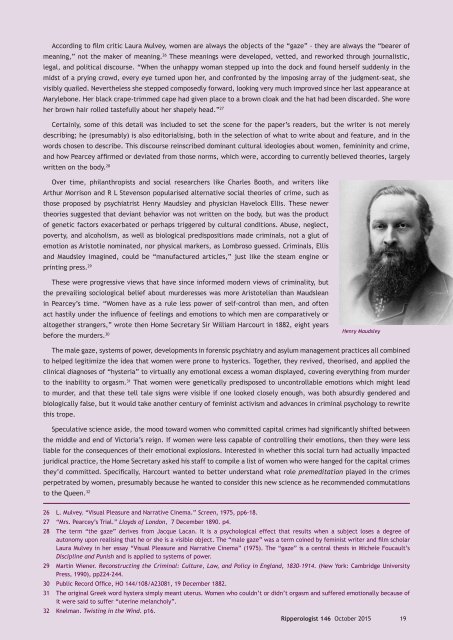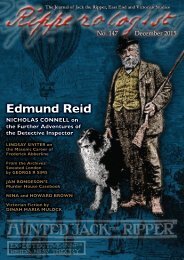GEORGE HUTCHINSON
orxwju5
orxwju5
You also want an ePaper? Increase the reach of your titles
YUMPU automatically turns print PDFs into web optimized ePapers that Google loves.
According to film critic Laura Mulvey, women are always the objects of the “gaze” - they are always the “bearer of<br />
meaning,” not the maker of meaning. 26 These meanings were developed, vetted, and reworked through journalistic,<br />
legal, and political discourse. “When the unhappy woman stepped up into the dock and found herself suddenly in the<br />
midst of a prying crowd, every eye turned upon her, and confronted by the imposing array of the judgment-seat, she<br />
visibly quailed. Nevertheless she stepped composedly forward, looking very much improved since her last appearance at<br />
Marylebone. Her black crape-trimmed cape had given place to a brown cloak and the hat had been discarded. She wore<br />
her brown hair rolled tastefully about her shapely head.” 27<br />
Certainly, some of this detail was included to set the scene for the paper’s readers, but the writer is not merely<br />
describing; he (presumably) is also editorialising, both in the selection of what to write about and feature, and in the<br />
words chosen to describe. This discourse reinscribed dominant cultural ideologies about women, femininity and crime,<br />
and how Pearcey affirmed or deviated from those norms, which were, according to currently believed theories, largely<br />
written on the body. 28<br />
Over time, philanthropists and social researchers like Charles Booth, and writers like<br />
Arthur Morrison and R L Stevenson popularised alternative social theories of crime, such as<br />
those proposed by psychiatrist Henry Maudsley and physician Havelock Ellis. These newer<br />
theories suggested that deviant behavior was not written on the body, but was the product<br />
of genetic factors exacerbated or perhaps triggered by cultural conditions. Abuse, neglect,<br />
poverty, and alcoholism, as well as biological predispositions made criminals, not a glut of<br />
emotion as Aristotle nominated, nor physical markers, as Lombroso guessed. Criminals, Ellis<br />
and Maudsley imagined, could be “manufactured articles,” just like the steam engine or<br />
printing press. 29<br />
These were progressive views that have since informed modern views of criminality, but<br />
the prevailing sociological belief about murderesses was more Aristotelian than Maudslean<br />
in Pearcey’s time. “Women have as a rule less power of self-control than men, and often<br />
act hastily under the influence of feelings and emotions to which men are comparatively or<br />
altogether strangers,” wrote then Home Secretary Sir William Harcourt in 1882, eight years<br />
before the murders. 30<br />
Henry Maudsley<br />
The male gaze, systems of power, developments in forensic psychiatry and asylum management practices all combined<br />
to helped legitimize the idea that women were prone to hysterics. Together, they revived, theorised, and applied the<br />
clinical diagnoses of “hysteria” to virtually any emotional excess a woman displayed, covering everything from murder<br />
to the inability to orgasm. 31 That women were genetically predisposed to uncontrollable emotions which might lead<br />
to murder, and that these tell tale signs were visible if one looked closely enough, was both absurdly gendered and<br />
biologically false, but it would take another century of feminist activism and advances in criminal psychology to rewrite<br />
this trope.<br />
Speculative science aside, the mood toward women who committed capital crimes had significantly shifted between<br />
the middle and end of Victoria’s reign. If women were less capable of controlling their emotions, then they were less<br />
liable for the consequences of their emotional explosions. Interested in whether this social turn had actually impacted<br />
juridical practice, the Home Secretary asked his staff to compile a list of women who were hanged for the capital crimes<br />
they’d committed. Specifically, Harcourt wanted to better understand what role premeditation played in the crimes<br />
perpetrated by women, presumably because he wanted to consider this new science as he recommended commutations<br />
to the Queen. 32<br />
26 L. Mulvey. “Visual Pleasure and Narrative Cinema.” Screen, 1975, pp6-18.<br />
27 “Mrs. Pearcey’s Trial.” Lloyds of London, 7 December 1890. p4.<br />
28 The term “the gaze” derives from Jacque Lacan. It is a psychological effect that results when a subject loses a degree of<br />
autonomy upon realising that he or she is a visible object. The “male gaze” was a term coined by feminist writer and film scholar<br />
Laura Mulvey in her essay “Visual Pleasure and Narrative Cinema” (1975). The “gaze” is a central thesis in Michele Foucault’s<br />
Discipline and Punish and is applied to systems of power.<br />
29 Martin Wiener. Reconstructing the Criminal: Culture, Law, and Policy in England, 1830-1914. (New York: Cambridge University<br />
Press, 1990), pp224-244.<br />
30 Public Record Office, HO 144/108/A23081, 19 December 1882.<br />
31 The original Greek word hystera simply meant uterus. Women who couldn’t or didn’t orgasm and suffered emotionally because of<br />
it were said to suffer “uterine melancholy”.<br />
32 Knelman. Twisting in the Wind. p16.<br />
Ripperologist 146 October 2015 19




